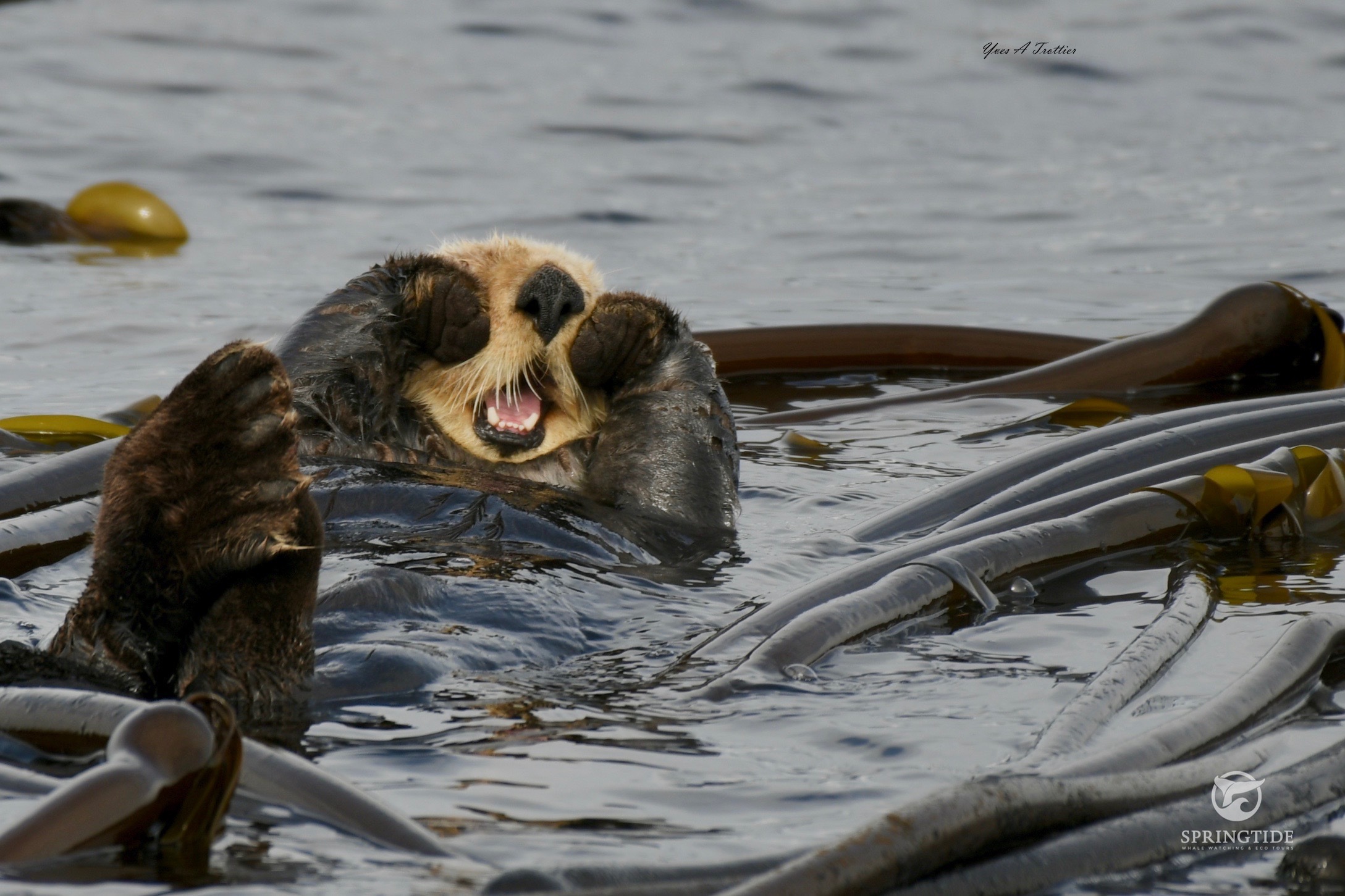Written by Christine Roper, SpringTide Naturalist
As a naturalist onboard our whale watching vessels, I often get a lot of questions about the otters we see in Victoria. Although we do have a healthy population of otters living around the rocky shores of Vancouver Island, most of these cute furry mammals are actually river otters adapted to living in salt water, rather than the true sea otters most people are familiar with. Although similar looking, river otters tend to be skinnier and less furry than their sea otter cousins, and spend much of their time running around on land as well as in the water. Over the past few years however, we have had the exciting chance to view true sea otters near Victoria, as an increase in their population has brought them closer to home.

Photo Credits: https://beachchairscientist.wordpress.com/2012/09/25/your-otter-know/
Sea otters, (scientific name Enhydra lutris), have had a troubled past off the west coast of British Columbia. Due to their thick fur, sea otters became a major target of the maritime fur trade in the 18th and 19th century. By the early 1900’s, sea otters had become completely extinct in British Columbia, with only small populations remaining in Alaska and California. Today, however, the news on sea otters is much less grim. Due to a ban in hunting, and reintroduction of a small population back into British Columbia, the sea otter populations off the west coast of Vancouver Island have been slowly increasing. This year, during many of our whale watching excursions, we have had the amazing opportunity to view these adorable marine mammals close to Victoria.
Sea otters are perfectly adapted to living in their cold water environment here off the west coast of British Columbia. Unlike their river otter cousins, sea otters spend almost their entire lives in the water, rarely coming onto dry land. In order to withstand the cold water in which they live, sea otters have the greatest density of fur of any mammal. Depending on the location on their body, sea otters can have as many as 170,000-1,000,000 hairs per square inch! Unlike many marine mammals such as seals and sea lions, sea otters have no insulating fat layer on their body to keep them warm in the water, therefore their amazingly dense fur serves to insulate them and keep them from becoming hypothermic. This thick fur needs to be clean however, in order for the insulating air layer to be maintained between the water and their skin. Sea otters can often be seen blowing into their fur and pushing it around with their paws, which traps the air in the hairs around their body and helps keeps them warm. An adult sea otter can spend up to 15% of their day simply grooming themselves!
When not grooming, sea otters spend a huge part of their day foraging for food. Their diet consists of a wide variety of organisms, including crabs, clams, snails, and sea urchins. An adult sea otter consumes approximately 25% of its body weight each day in order to maintain its high metabolism! Amazingly, sea otters are one of the few mammals on Earth which utilize tools to help them feed; a skill which was once thought to be possessed only by humans. Sea otters can often be seen using rocks, driftwood, or even empty clam shells to help them break into the tough shells of their prey. While feeding, sea otters drift on their backs and use their stomachs as a “table” which they can hold their food on while they crack open its shell. Although tool use seems like a fairly standard behaviour for us humans, determining which tool will help the otter open its food requires forward planning, problem solving and learning skills, all linked to complex cognitive ability. Therefore, sea otters must have relatively advanced structures within their brain to make these connections.
Not only are sea otters one of the most adorable mammals found in our ocean, they also play an essential role in their marine ecosystem. Known as a keystone species, sea otters have a greater effect on their environment than other organisms within that system. As predators within their food web, sea otters help protect important kelp ecosystems by controlling the abundance of herbivorous invertebrates such as sea urchins. Without predation by otters, sea urchin populations can grow so large they will devour the kelp forests. These forests are essential ecosystems because they provide an important habitat, nursery, and food source for many marine organisms. Therefore, sea otters play a direct role in the survival and protection of many other animals within its ecosystem. In addition, sea otters also play an indirect role in the reduction of carbon emissions into our atmosphere. By protecting the kelp from being entirely consumed by sea urchins, kelp forests are able to flourish and remove carbon, which they use for photosynthesis.
Although they are one of the smallest marine mammals we see in our area, sea otters are one of the most charismatic and well known animals in the Pacific Northwest. Their interesting anatomy and key role within their ecosystem also make them a popular mammal to study. Although sea otter populations are continuing to increase around British Columbia, they are not out of the woods quite yet. Anthropogenic – or human caused – events such as oil spills, fishing net entanglement, and habitat degradation are a serious threat to sea otters, and can have major impacts on their population. Conservation strategies such as increased net regulations and reduced chemical run-off from land are good first steps that can be taken to help protect these marine mammals. Nevertheless, we are thrilled to see that the sea otter population is increasing around Victoria, and hope this adorable new addition to our area is here to stay!
Written by Christine Roper, SpringTide Naturalist

